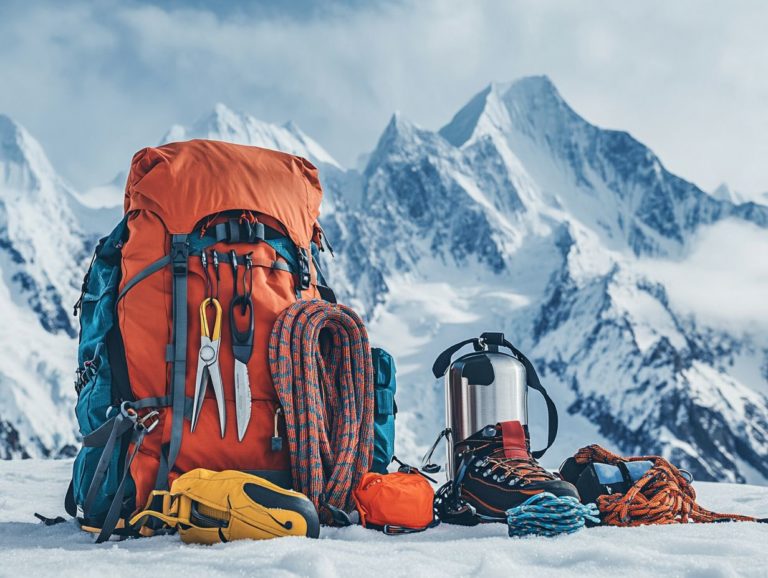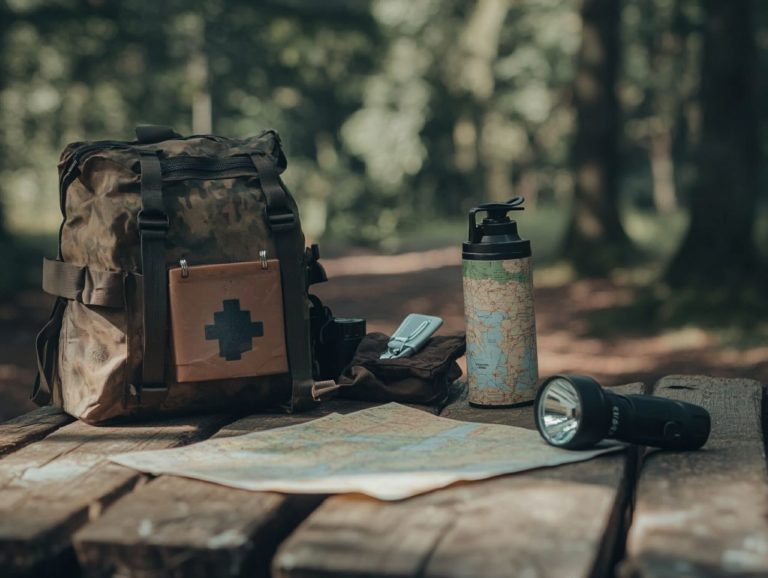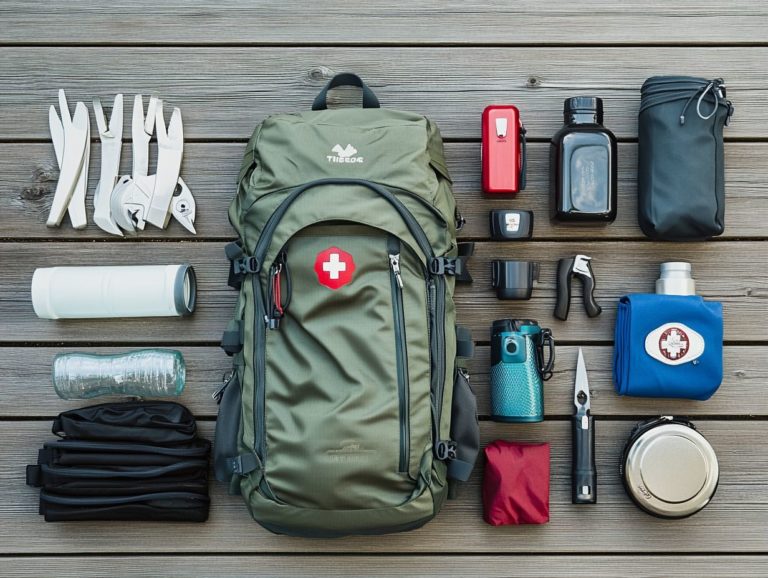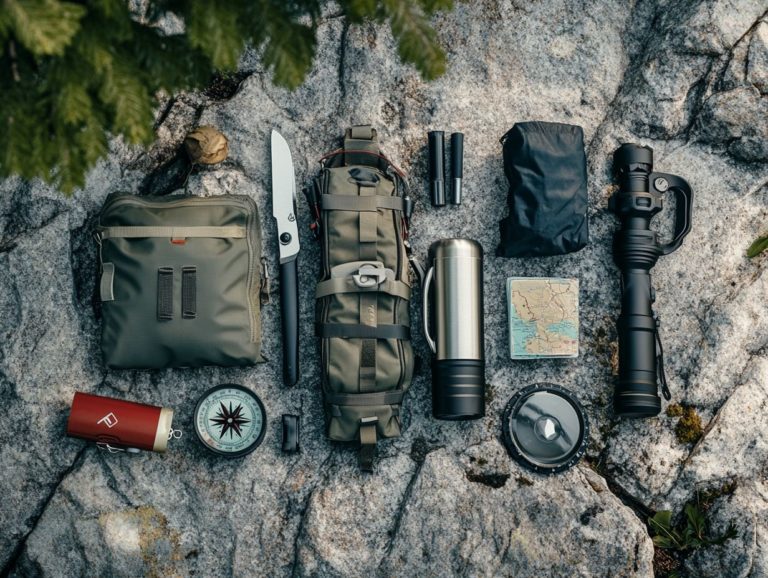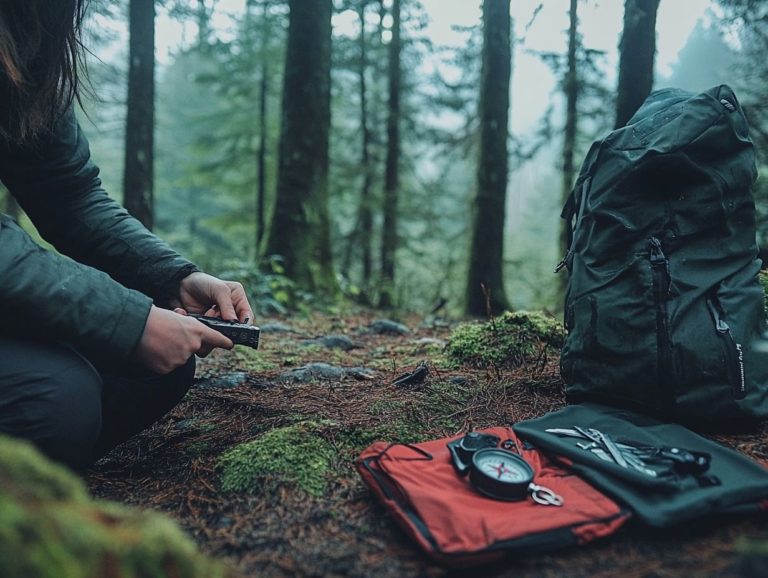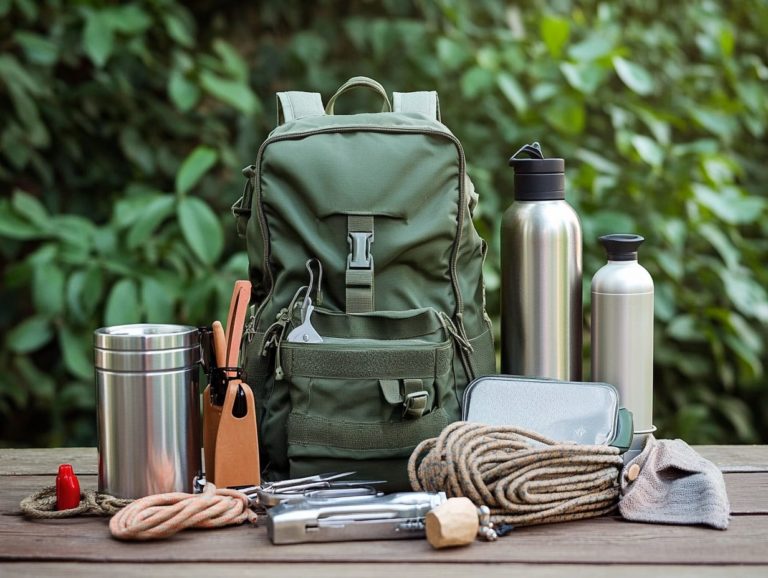The Best Survival Gear for Day Hikes
Heading out for a day hike can be an exhilarating experience, but it demands thoughtful preparation.
Selecting the right survival gear is essential for ensuring both your safety and enjoyment in the great outdoors. This article delves into the must-have tools and equipment every hiker should consider, from navigation aids and reliable communication devices to first aid kits and emergency shelters.
It also highlights important factors for choosing gear tailored to your specific trip, common packing mistakes to avoid, and tips for staying safe during your adventure. Get ready to make your next hike not only enjoyable but safe!
Contents
- Key Takeaways:
- 1. Essential Navigation Tools
- 2. Reliable Communication Devices
- 3. First Aid Kit
- 4. Emergency Shelter
- 5. Water and Water Purification Methods
- 6. High-Energy Snacks
- 7. Multi-Tool or Knife
- 8. Fire-Making Tools
- 9. Protective Clothing and Gear
- 10. Sun Protection
- 11. Illumination Tools
- 12. Emergency Whistle
- 13. Personal Locator Beacon
- 14. Survival Manual
- 15. Extra Supplies for Specific Needs
- What Are the Most Important Factors to Consider When Choosing Survival Gear for Day Hikes?
- Common Questions About Hiking Gear
- What is the best survival gear for day hikes?
- Why is a sturdy backpack important for day hikes?
- What should I look for in a water filter or purifier for day hikes?
- Do I really need a first aid kit for day hikes?
- Why is it important to bring a map and compass on a day hike?
- What type of multi-tool is best for day hikes?
Key Takeaways:
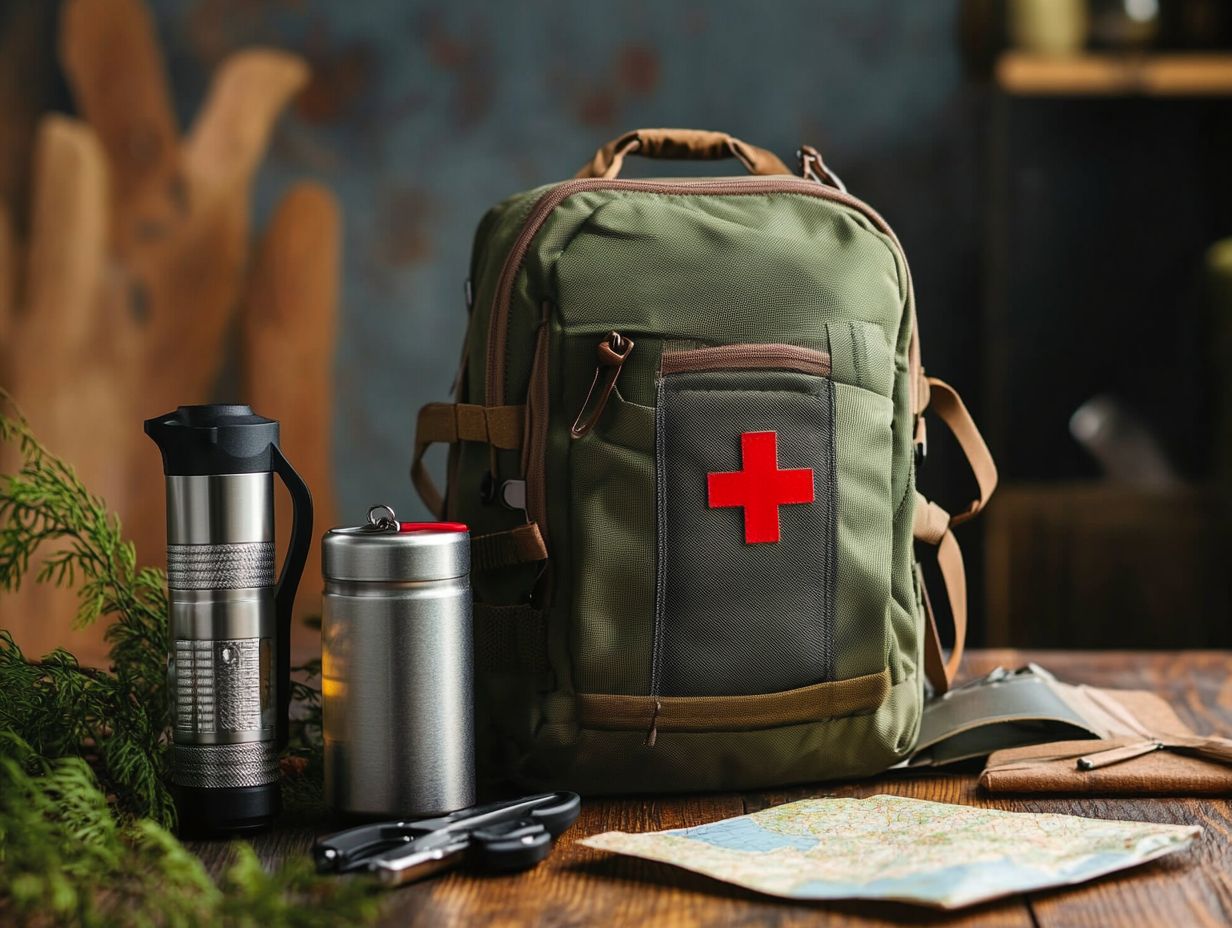
- Always carry essential navigation tools, such as a map, compass, and GPS device, to avoid getting lost on a day hike.
- Reliable communication devices, like a cell phone or satellite phone, can be lifesaving in emergency situations on a day hike.
- A well-stocked first aid kit is crucial for treating any injuries or medical emergencies that may occur during a day hike.
When you set out on hiking trips, having the right navigation tools is essential for ensuring both your safety and success on the trails, particularly in diverse landscapes like Arizona or along iconic routes such as the Camino de Santiago.
Accurate and reliable navigation gear can greatly elevate your hiking experiences while keeping you from getting lost or encountering potential mishaps. Among the must-have tools in your arsenal are trail maps, which provide comprehensive insights into the terrain, points of interest, and available resources.
A well-marked map, paired with a navigation compass, gives you the power to orient yourself and make informed decisions about your route. Mastering the use of these tools is key to preventing you from straying off the path, especially in remote areas where every turn counts.
GPS devices and smartphone apps have become essential in modern hiking, offering real-time tracking and the ability to upload or download trail data. Using both modern technology and traditional navigation methods will improve your hiking experience.
2. Reliable Communication Devices
Stay safe during your adventures with reliable communication devices! They serve as a lifeline in emergencies and enhance your hiking adventures by allowing you to stay connected with others.
In the wilderness, nature’s unpredictability can catch even the most experienced adventurers off guard. It’s crucial to be equipped with tools designed for those unexpected moments. Personal locator beacons (PLBs) are helpful tools for this purpose, as they allow you to send distress signals and pinpoint your location for rescue teams if you find yourself in a critical situation.
Integrating solar chargers into your hiking kit ensures that your devices remain powered, allowing for continuous communication and access to essential information, even in the most remote areas. By thoughtfully including these tools in your emergency kit, you can embark on your explorations with greater confidence and peace of mind.
3. First Aid Kit
A well-stocked first aid kit is a collection of medical supplies used to treat injuries and is an essential component of your hiking survival arsenal. It provides crucial supplies for dealing with common injuries and emergencies that could happen during your outdoor adventures.
This vital kit should be both compact and comprehensive, featuring items such as:
- Adhesive bandages
- Antiseptic wipes
- Gauze pads
- Adhesive tape
- Scissors
Ensure all these items are neatly organized within a lightweight backpack. Having these supplies readily available allows you to respond swiftly to situations like cuts, scrapes, or insect bites common occurrences during explorations.
Simply possessing first aid items isn t enough; understanding survival skills significantly enhances their effectiveness. With this knowledge, you ll be better equipped to assess situations and administer care effectively, maximizing safety and minimizing potential complications in the wild.
4. Emergency Shelter
Having an emergency shelter ready is crucial for your outdoor safety. It protects you from harsh weather and helps you survive unexpected situations while hiking.
These shelters come in various forms, like tents, tarps, and bivy sacks. They are carefully made to shield you from wind, rain, and snow.
Thermal and mylar blankets are must-have accessories. They keep your body heat when temperatures drop.
Compact and lightweight, these items fit perfectly in your camping gear. Their ability to keep you warm is vital for survival.
5. Water and Water Purification Methods
Access to clean water is critical for hikers. Effective water purification methods and quality hydration packs are essential for your hiking survival kit.
Whether you re on remote trails or enjoying a day hike, ensure your water sources are free from harmful contaminants.
Water purification tablets are a convenient way to eliminate bacteria and viruses. Portable filters like Life Straws let you drink directly from streams or lakes safely.
Adding a hydration bladder or pack to your gear gives you easy access to clean water. Staying hydrated boosts your stamina and overall health, allowing you to enjoy every moment outdoors.
6. High-Energy Snacks
You need high-energy snacks to keep your energy up while hiking. They fuel your endurance on long trails and keep safety in mind.
These portable snacks offer convenience and help maintain consistent energy levels. Stay alert and ready for any terrain.
Trail mixes are among the best options, blending nuts, seeds, and dried fruits for a balance of healthy fats, proteins, and carbohydrates.
Energy bars with oats and natural sweeteners are satisfying and easy to consume on the go. Jerky, rich in protein, keeps hunger at bay without weighing down your backpack.
7. Multi-Tool or Knife
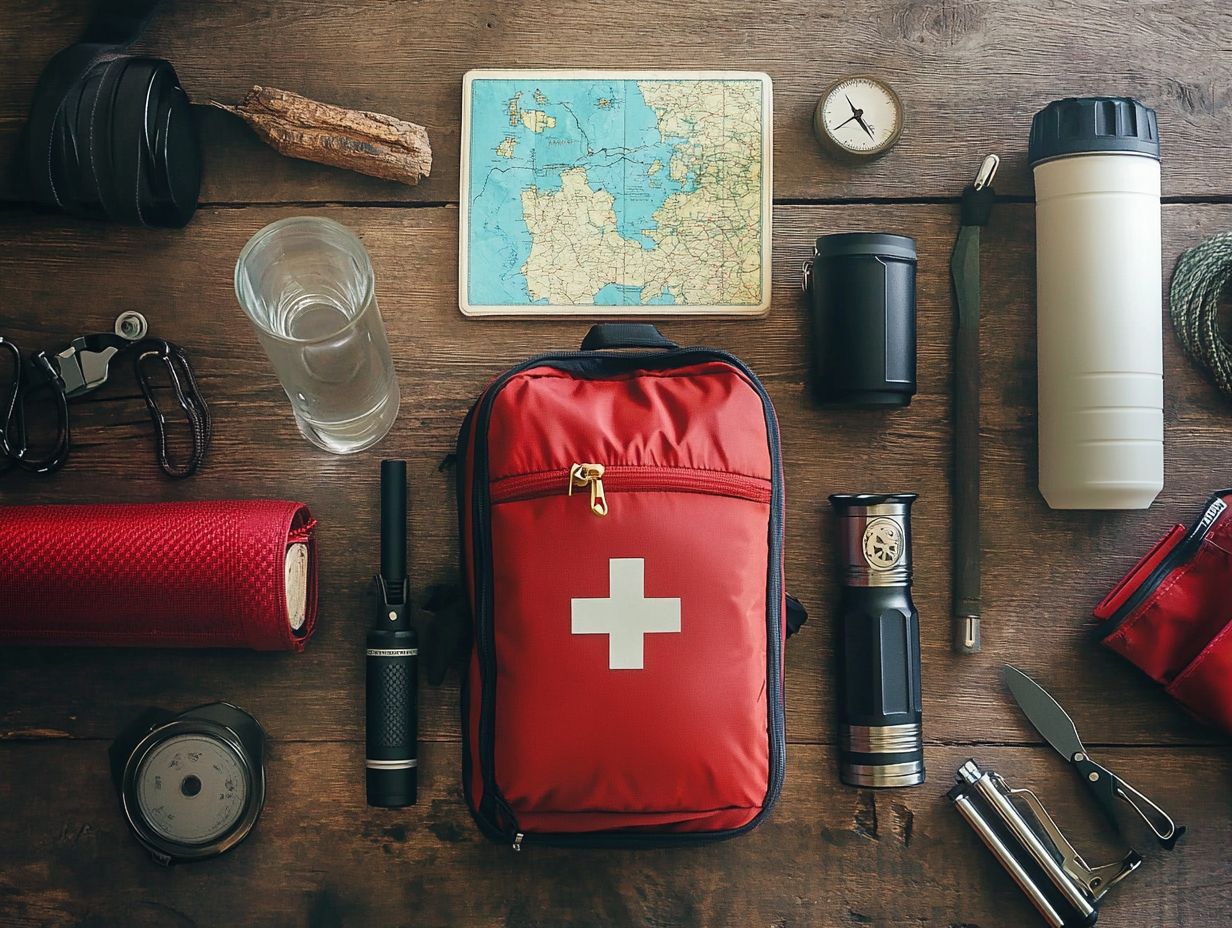
A multi-tool or pocket knife is essential for your camping gear. These tools make a big difference in your outdoor experience.
Use them to slice rope, open food cans, or quickly repair gear. In emergencies, they can be lifesaving.
Imagine cutting bandages or starting a fire. Having one as part of your emergency kit prepares you for the unexpected.
These compact tools blend convenience with vital survival features, giving you peace of mind whether you’re a seasoned adventurer or a casual camper.
8. Fire-Making Tools
Fire-making tools, like waterproof matches and dependable fire starters, are essential survival gear. They provide warmth and uplift your spirits during outdoor adventures. Carrying bear spray helps manage wildlife encounters safely.
These tools are integral to a well-rounded camping setup, ensuring you’re prepared for various weather conditions. Whether it s the reliable spark of a fire starter or the convenience of a magnesium fire starter, each option has unique advantages.
Having a dependable method to spark a flame can change the dynamics of any survival situation. It allows you to cook food, signal for help, and keep wildlife at bay. High-quality fire-making equipment enhances your safety and enriches your camping experience.
9. Protective Clothing and Gear
Choosing the right gear can make or break your next hiking adventure! Investing in quality hiking boots and breathable fabrics greatly enhances your experience.
As you navigate different terrains, lightweight layers are essential. A good backpack will help carry your gear comfortably.
Choose moisture-wicking shirts and quick-dry pants. These items keep you cool and comfortable. In colder climates, insulated gear is a must for harsh conditions, along with thermal layers that maintain warmth and are lightweight.
Consider a packable down jacket paired with a thermal blanket and waterproof outer layers. On sunny trails, wear a wide-brimmed hat and UV-protective clothing to protect yourself from harmful rays.
Every piece of gear you select plays a pivotal role in elevating your hiking experience. It allows you to immerse yourself in nature instead of wrestling with the elements.
10. Sun Protection
Sun protection is crucial for outdoor adventures. Use broad-spectrum sunscreen to prevent sunburn and skin damage.
For anyone planning to immerse themselves in nature, effective sun protection methods are essential. Apply a sunscreen with a high SPF to shield your skin from harmful UVA and UVB rays. Fire starter kits can help when setting up camp, but don t forget your emergency kit!
Wear protective clothing like lightweight, long-sleeved shirts and pants; these provide an extra layer of defense. A wide-brimmed hat is a must-have it offers shade for your face and neck while reducing the risk of heat exhaustion.
By taking these simple precautions, you can not only protect yourself but also fully enjoy your outdoor adventures!
11. Illumination Tools
Illumination tools like lightweight flashlights and adventure gear such as headlamps for night hikes are essential for your nighttime outdoor escapades. They ensure safety and visibility during your after-dark hiking adventures.
These tools are critical for illuminating paths and spotting potential hazards. Navigation tools can help you avoid them, significantly enhancing your overall experience in the great outdoors. When deciding between headlamps and traditional flashlights, it s important to recognize that each offers unique advantages tailored to specific scenarios.
For instance, headlamps provide the convenience of hands-free operation, which becomes crucial when using your multi-tool knife. This makes them perfect for tasks that require both hands, such as setting up a campsite or navigating tricky terrains. Traditional flashlights typically deliver a more focused beam and a higher brightness level, which you can compare when choosing between brands like Energizer and Coast. This can be particularly advantageous for short-distance visibility in open spaces.
By grasping the benefits of each option, you can make informed choices that best fit your adventurous needs. Pack your survival experience by having a complete trail-ready kit accordingly.
12. Emergency Whistle
An emergency whistle is an essential tool that deserves a spot in your hiking kit. It serves as a vital means of signaling for help in case of injuries or sudden weather changes. Consider packing waterproof matches and a thermal blanket to mitigate potential threats.
Its lightweight design allows for easy carrying in your hiking backpack, ensuring it won t add unnecessary bulk. This compact device can produce a sound that travels far beyond the human voice, significantly boosting your chances of being heard by rescuers in critical situations.
But it s not just about grabbing attention; an emergency whistle enhances your overall outdoor safety by providing a dependable way to communicate distress. This is essential when you re far from help. In remote areas where cell phone reception is often nonexistent, this simple yet effective gadget could be a lifesaver, giving you peace of mind as you immerse yourself in nature.
13. Personal Locator Beacon
A personal locator beacon is an essential safety tool for hikers, providing a reliable way to communicate with emergency services when you need immediate assistance.
These devices empower outdoor enthusiasts like you to send distress signals even in the most remote areas where traditional cell phone coverage simply doesn’t reach. By just activating the beacon, you can transmit your exact GPS coordinates, which are crucial for finding your way in the wilderness. This significantly boosts your chances of a swift rescue.
This capability becomes critically important in emergencies, such as injuries or sudden weather changes, where every minute counts. Including a personal locator beacon in your emergency kit not only enhances your overall safety but also elevates your survival experience, offering you peace of mind as you navigate the great outdoors.
14. Survival Manual
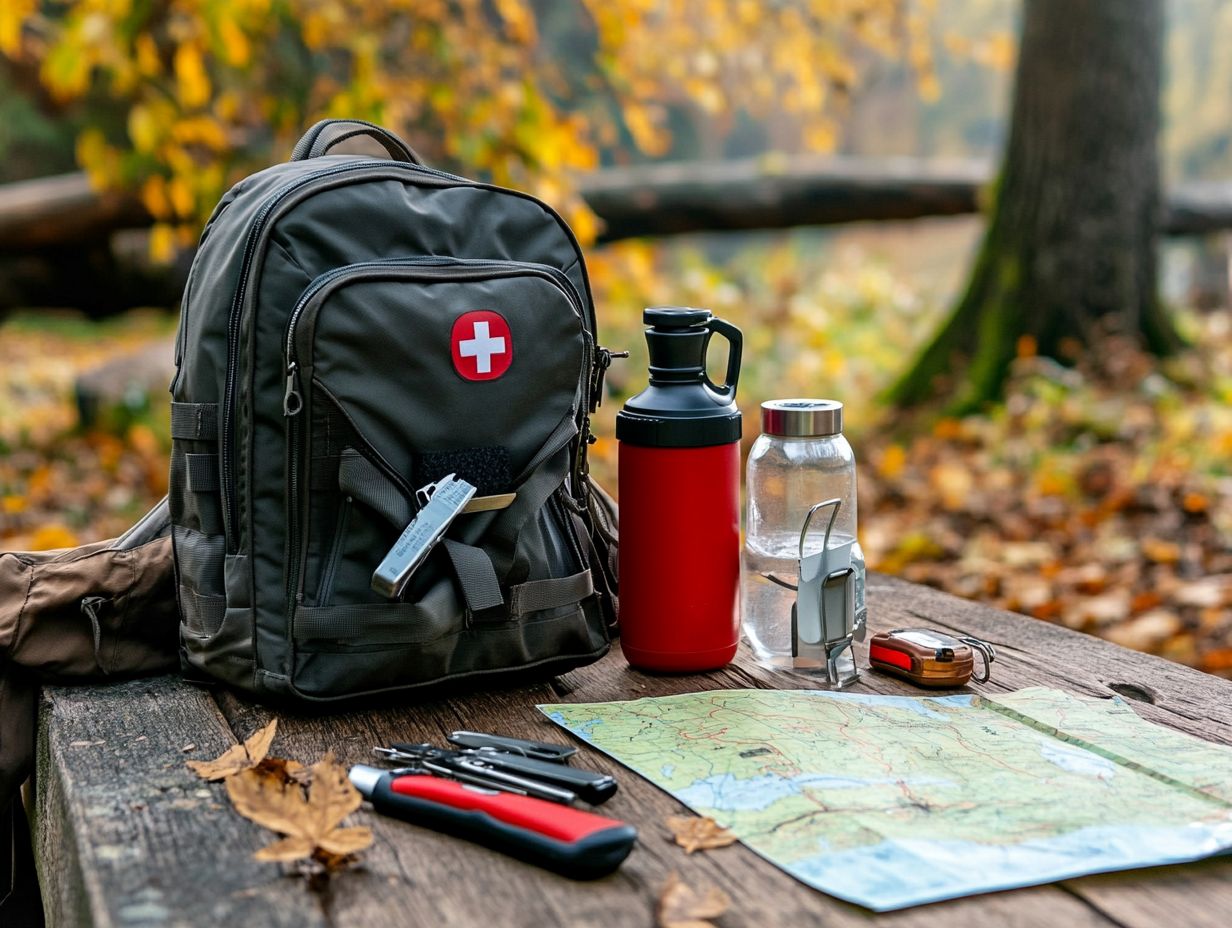
A survival manual is an invaluable resource for hikers. It offers essential guidance on life-saving skills that can prove crucial in challenging outdoor situations.
This manual should encompass critical areas such as first-aid techniques, enabling you to manage injuries or illnesses effectively until professional help can arrive.
Include navigation skills, using a compass to help you read maps and avoid getting lost in unfamiliar terrains.
The inclusion of shelter-building methods and a mylar blanket for emergencies is vital. This ensures you know how to create safe and warm refuges from harsh weather conditions.
By incorporating these elements, the manual boosts your preparedness and enhances outdoor safety, equipping you with the confidence to tackle unpredictable environments.
15. Extra Supplies for Specific Needs
Carrying extra supplies tailored to your individual needs is essential for ensuring a comfortable and safe hiking experience. Properly preparing your camping essentials is particularly important when venturing into specific outdoor activities or unique environments.
For instance, if you’re navigating arid terrains, efficient hydration systems like CamelBak are beneficial. Pack additional hydration options, such as collapsible water bladders or electrolyte-infused drinks, to keep dehydration at bay.
On the flip side, if you’re tackling colder climates, prioritize insulated gear and clothing designed to retain body heat.
Specialized tools, like trekking poles for stability on uneven trails or compact survival kits with duct tape for quick repairs, can enhance your safety and confidence on rugged paths.
Think about what you need to make your adventure unforgettable. By thoughtfully considering your personal requirements and the environmental challenges ahead, you can significantly boost your chances of thriving in nature.
What Are the Most Important Factors to Consider When Choosing Survival Gear for Day Hikes?
Choosing the right survival gear for your day hikes requires careful consideration of several factors. These include the nature of your hiking trip, the terrain you’ll encounter, and the essentials that promote outdoor safety and comfort.
Weather conditions are critical, as they can profoundly impact both your experience and safety on the trail. If the forecast suggests rain or extreme temperatures, selecting the appropriate gear becomes paramount.
The size of your hiking group also plays a role in determining the equipment needed. Larger groups may necessitate additional supplies and a more comprehensive first-aid kit.
Your personal experience is another factor to consider. If you re new to hiking, investing in lightweight, high-quality gear that offers versatility without weighing you down is a smart move.
When you carefully select your camping gear, you not only enhance your comfort but also bolster your safety. Be ready your safety depends on it!
How Can One Determine What Gear Is Necessary for Their Specific Hiking Trip?
Determining the necessary gear for your specific hiking trip requires a keen understanding of trail conditions, expected weather, and the unique outdoor safety requirements that must be assessed before setting out.
Trail conditions should dictate what gear you bring along. For example, if you’re tackling steeper trails, you might want to invest in special grips for your shoes to save you from slips and falls. Soggy paths will have you reaching for waterproof footwear, which is essential for wet or muddy trails.
- Start by assessing trail conditions, paying attention to elevation changes, as they can significantly influence both the difficulty of your hike and the type of gear you ll need.
- Next, check the local weather patterns closely. Sudden temperature shifts or the threat of rain can greatly impact your choice of layers and gear. Don t forget to consider your own survival skills, as these will guide your decisions about safety equipment.
- If you re a novice, prioritize a comprehensive first-aid kit, which is a must-have for day hikes. A seasoned hiker may prefer a minimalist approach, opting for essential tools like a multi-tool knife that align with their confidence and experience level.
What Are Some Common Mistakes to Avoid When Packing Survival Gear for a Day Hike?
Packing your survival gear? It’s a must for a thrilling and safe adventure on the trails! Avoiding common mistakes is essential to ensure your outdoor safety and a pleasant hiking experience.
One of the biggest blunders hikers often make is overpacking, which adds unnecessary weight and can lead to fatigue that dampens your spirit on the trail. To avoid this, it’s crucial to know what to pack for a day hike. Forgetting essential items like a first-aid kit, enough water, or clothing suited for the weather can transform a simple hike into a confusing ordeal when unexpected challenges arise.
Always check the local weather forecast, hydration pack, and pack accordingly since conditions can change in the blink of an eye. To streamline your packing process, consider creating a checklist for your essential first aid kit for hikers. This way, you can ensure that all the crucial items are included while also focusing on selecting lightweight gear, a lightweight backpack, and a water bottle that enhances your enjoyment of the trail.
How Often Should One Update or Replace Their Survival Gear?
Regularly updating or replacing your survival gear is essential for maintaining outdoor safety and ensuring that all your hiking essentials are in peak condition for every adventure.
Faded straps, frayed cords, and rusted zippers are clear indicators of wear and tear that could compromise the performance of your gear. Changes in your personal needs like increased distance or varying environmental conditions may necessitate an upgrade.
It’s also important to consider the latest advancements in technology; newer models often come equipped with safety features that simply weren’t available before. Keeping your gear in optimal condition not only enhances your safety but also boosts your confidence, allowing you to fully immerse yourself in your adventure without the nagging worry of potential gear failures.
What Are Some Additional Tips for Staying Safe and Prepared on a Day Hike?
Staying safe and prepared on a day hike is about more than just having the right gear; it s also about adopting a proactive mindset and implementing additional safety tips that can elevate your overall hiking experience.
- Inform someone about your itinerary. Make sure someone knows your route and expected return time.
- Understand the trail ahead its challenges and weather conditions can help you mitigate risks effectively.
- Having a contingency plan is wise, allowing you to adapt to unexpected scenarios like sudden weather changes or personal emergencies.
- Practice essential survival skills, such as building a fire or navigating with a map and compass, to enhance your safety and instill the confidence needed to handle any unforeseen circumstances that may arise during your hike.
Common Questions About Hiking Gear
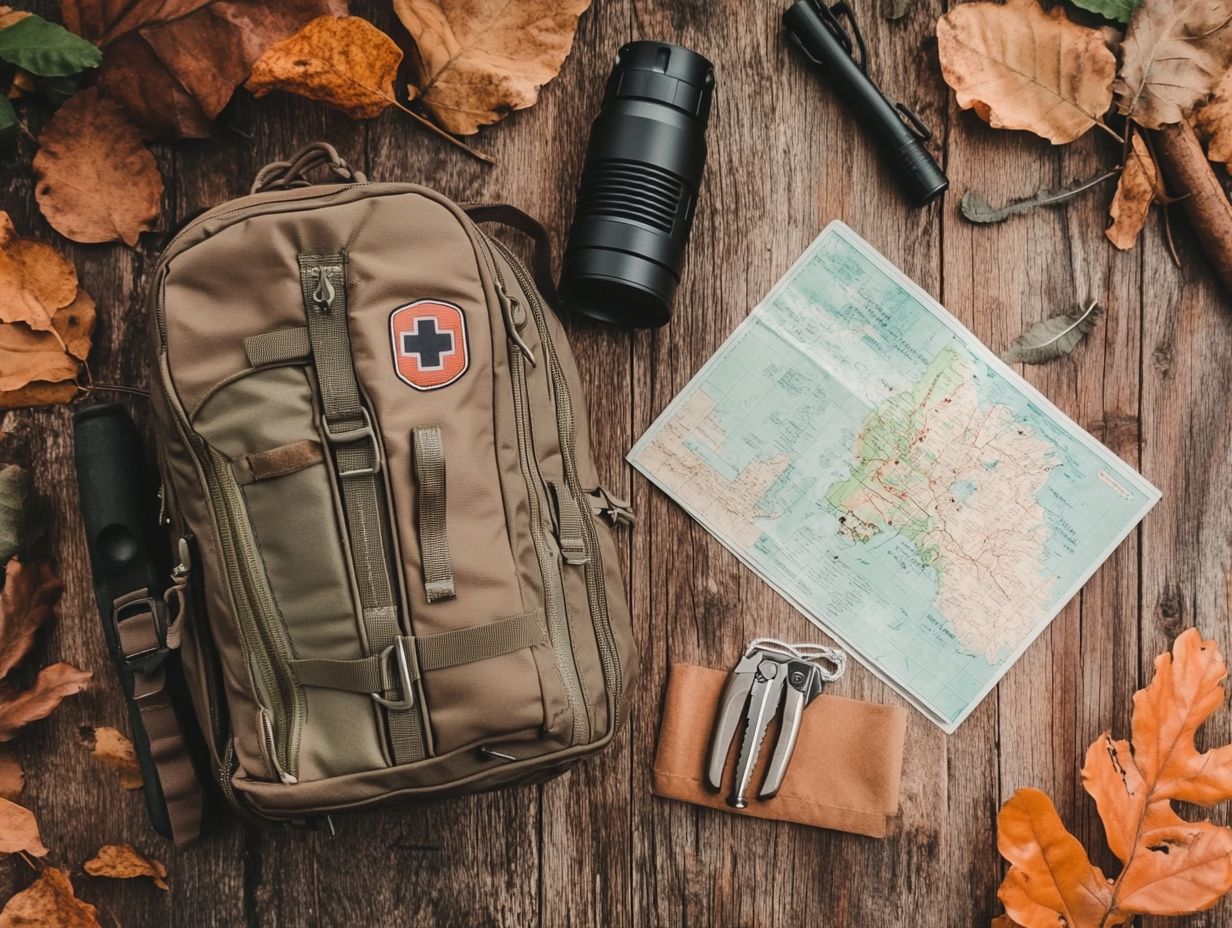
What is the best survival gear for day hikes?
The best survival gear for day hikes includes a sturdy backpack and a collapsible bowl. You’ll also need a reliable water filter, like a Life Straw, a first aid kit, and a lightweight flashlight.
Don’t forget your map and compass, a multi-tool, and an emergency shelter with an emergency blanket!
Why is a sturdy backpack important for day hikes?
A sturdy backpack is vital for day hikes! It helps you carry all your gear comfortably and securely.
What should I look for in a water filter or purifier for day hikes?
Look for a lightweight and compact water filter that effectively removes bacteria and other impurities. A collapsible cup is a great bonus!
Do I really need a first aid kit for day hikes?
Yes, a first aid kit is crucial! It contains important medical supplies to treat minor injuries and illnesses on the trail.
Why is it important to bring a map and compass on a day hike?
A map and compass help you navigate unfamiliar trails. They keep you on track and safe!
What type of multi-tool is best for day hikes?
A multi-tool with essential features like a knife, scissors, screwdriver, and pliers is perfect for day hikes. It comes in handy for various tasks and emergencies!

